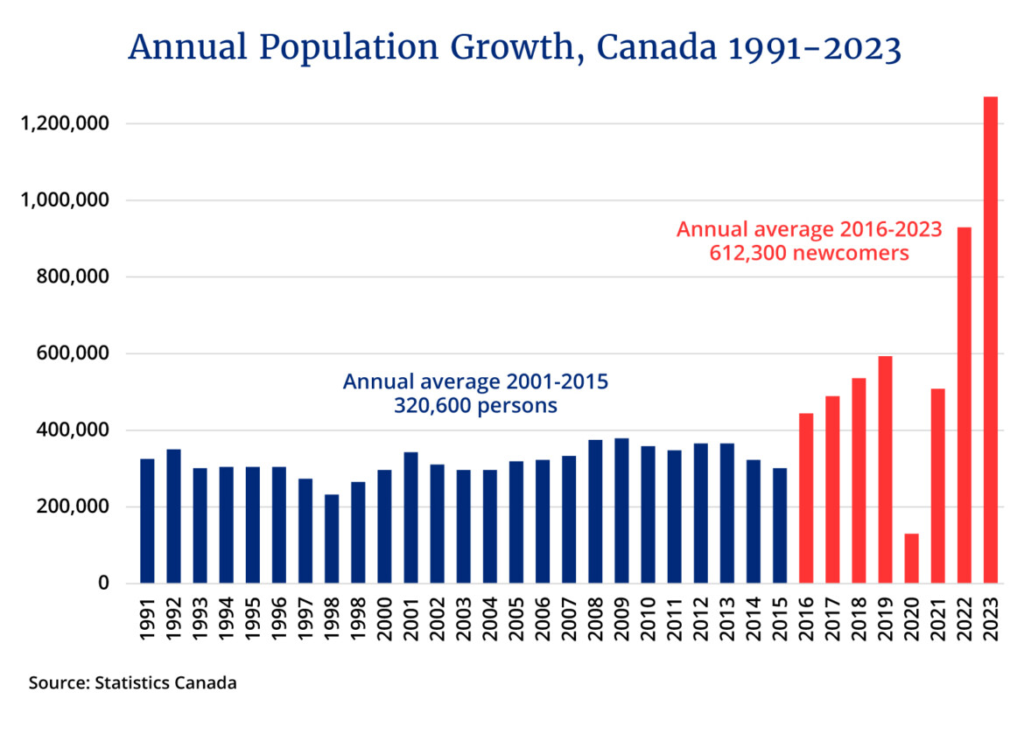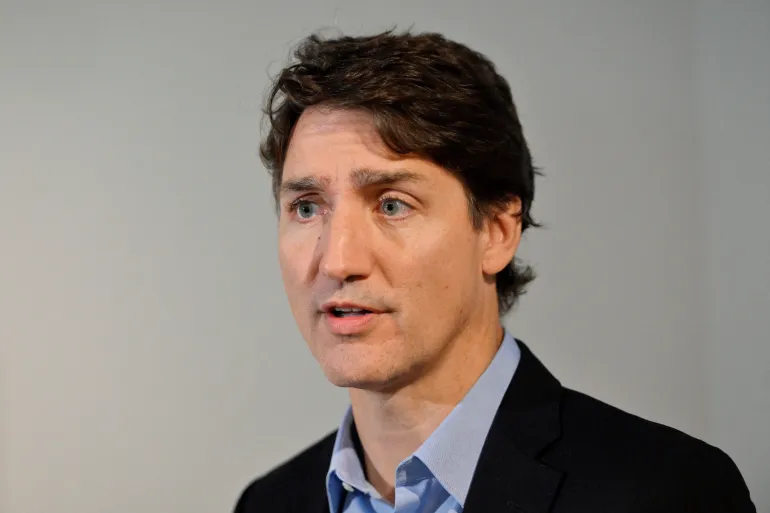Editor’s note: This article was originally published on Population Institute Canada’s website (populationinstitutecanada.ca) on January 10th, 2025. It is republished on Dominion Review in slightly abridged form with permission of the author. First, Population Institute Canada President Madeline Weld discusses the global reliance on the model of endless economic growth, then she moves on to Canada’s current situation in regards to mass uncontrolled immigration, and ends off on an optimistic note with some New Year population and immigration wishes.
The new year could prove to be more exciting than many of us might wish. The spirit of “Peace on Earth and good will toward men” is in short supply in extensive regions of the world. Even in the relative tranquility of Canada, there is a lot of turmoil. An increasingly unpopular government facing plummeting polls and a possible no-confidence vote in parliament seems to be setting policies in panic mode, rather than through careful deliberation.
Recently the country was threatened with massive tariffs from its primary trading partner unless it takes better control of its border. But, despite the outrage that threat has evoked among some Canadians, it could be a blessing in disguise. More terror suspects have been arrested for attempting to cross into the US from its northern border than from its southern border. Do we really want those people in Canada? And shouldn’t we be asking how they got here?
Population Institute Canada’s wish list for 2025 reflects our focus, globally and domestically, on population and its interconnection with environmental, economic, social and political issues.
Globally and in Canada, growth remains the objective even as constraints become evident
In a staggering display of cognitive dissonance, political and economic leaders around the world still set growth as a primary objective. Regarding matters of environmental concern, they have focused almost exclusively on climate change. There seems to be little awareness that any effect we may have on Earth’s climate is merely one of many symptoms of a human species in overshoot. Humanity has entered into a “plague phase” as exemplified by biodiversity loss, deforestation, overfishing, depletion of water resources, pollution, and our drive to destructively scour every nook and cranny of land and water for resources to feed the demands of our “modern techno-industrial” economy which is based on a paradigm of continuous growth.
As Malthus noted over 200 years ago, every increase in food production has resulted in an increase in population. Enabled by the Haber-Bosch process and the Green Revolution, this is exactly what has happened in a spectacular way during the 20th century, which began with 1.5 billion people and ended with 6 billion. The over-rated “Demographic Transition” has been slow to catch on in sub-Saharan Africa and several other regions in the world. And so we see, in the poorest countries, burgeoning urban slums whose residents have low prospects of finding decent employment or being able to achieve even a modest quality of life. This creates push factors to migrate to wealthier countries, legally and illegally, creating political and social tensions in those countries.
Even as support for family planning languishes, massive efforts are put into developing renewable energy, often at high environmental cost, in an effort to fight climate change. Going electric has been touted as our environmental salvation and appears to be seen by many as the path to perpetual economic growth – as if such a thing were possible on a finite planet.
The data paint a much grimmer picture. Electricity is not a primary energy source. Electricity is produced through the conversion of primary energy sources, which include fossil fuels (coal, oil, natural gas), and nuclear, solar, wind, hydro, and biomass energy. Although an increasing proportion of the electricity consumed is produced from primary sources other than fossil fuels (such as wind and solar), only about one-fifth of primary energy is consumed in the form of electricity.
Globally the proportion of energy consumed in the form of electricity has been fairly stable since 2020 and made up 20.6% of the final global energy consumption in 2023. Despite renewables providing a greater proportion of electrical energy, wind and solar provided only 13.7% of the power for electricity in 2023. Therefore, they provided only 2.82% (0.206 x 0.137) of total energy consumption. It does not seem realistic to expect that wind and solar will be able to come close to meeting the world’s energy needs in any foreseeable timeframe. While Canada generates much of its electricity from hydro, most countries are not blessed with such abundant water resources.
Most primary energy is still consumed in the form of fossil fuels. Although their share of primary energy has declined in the last half century, from 93.4% in 1965 to 81.5% in 2023, the rate of decline is showing no signs of acceleration.

An interactive version of the graph below, showing the share of fossil fuels in primary energy consumption from 1965 to 2023, can be viewed at Statista.

While the share of fossil fuels in primary energy consumption during the last few years has declined modestly at best, the total amount of energy consumed has risen spectacularly, from 52,523 terawatt-hours (TWh) in 1965 to 183,230 TWh in 2023. Consequently, the consumption of fossil fuels, along with other sources of energy, has increased. An interactive version of the graph below can be viewed at Our World in Data.

In a nutshell, the world still runs mostly on fossil fuels, a finite non-renewable resource. While wind and solar cannot even keep up with the annual increase in the global demand for energy, they are being touted as our salvation and used to enable more growth (for the time being). In reality, this growth will just hasten collapse.
Canada in disarray
Meanwhile, in Canada, the government is seeing the chickens of its mass immigration policy come home to roost. After years of ignoring growing concerns about the impact of this policy, the government is now feeling the full wrath of Canadians who have seen housing prices and rents skyrocket, unprecedented demands on food banks, household debt reach record levels, and job quality decline as cheap labour flooded into the country. A prime minister who said that fighting climate change was as important as being able to afford food and rent came across as stunningly tone-deaf.
In fairness, Canada’s policy of mass immigration was not initiated by the current government. It began in earnest under the government of Brian Mulroney, in 1990, when his immigration minister Barbara McDougall pushed through a policy of bringing in a quarter million new permanent residents each year, regardless of economic conditions. This madness has been pursued by every government since. But Justin Trudeau’s government cranked it up to new levels and brushed off any advice that things might go sideways.
In October 2017, then immigration minister Ahmed Hussen announced that 300,000 new immigrants each year would be the “new normal” and floated the option for even higher levels for 2018 and beyond. And, in fact, the number of newcomers was much higher. The term “immigrant” designated only permanent residents, and did not include temporary workers or international students.
In November 2022, then immigration minister Sean Fraser announced that Canada had “welcomed over 405,000 newcomers,” the most ever, in the last year. He set permanent resident targets of 465,000 for 2023, and 485,000 and 500,000, respectively, for 2024 and 2025. Marc Miller vowed to continue with those targets after he became immigration minister in July 2023, despite mounting concerns about the housing crisis, and even chided Canadians who opposed the government’s policy for blaming immigrants and not having their best interest at heart. It did not seem to have crossed the mind of anyone in cabinet that it was the best interests of Canadians that they should be concerned about.
Even Statistics Canada was recruited to push mass immigration madness, producing a cringy propaganda video that celebrated the achievement of Canada reaching a population of 40 million in June 2023.
Meanwhile, the numbers of temporary foreign workers and international students, not included in the above-cited immigration targets, were also surging to such an extent that the government later admitted they had gotten out of control. In addition, the number of annual refugee applicants skyrocketed from about 16,000 in 2015, the year Trudeau was first elected as prime minister, to close to 147,000 from January to September 2024 (which if applied to the whole year would total almost 200,000).
Since January 2017, approximately 100,000 people were also allowed to enter Canada illegally, primarily at the decommissioned border crossing of Roxham Road between New York state and Quebec. It seems that everyone except the government was aware that a large amount of fraud was being committed by people entering Canada through various routes. An immigrant from “Pangea” shared stories from his own community with me, while pointing out that similar things would be going on in ethnic communities throughout Canada.
The graph below shows the number of newcomers of all categories entering Canada each year from 1991 to 2023. Much of the increase in recent years (aside from 2020, where travel was reduced due to Covid) is from temporary foreign workers and international students.

The graph below illustrates how the number of temporary workers in various categories was allowed to rise with little oversight under the current government.

In response to dismal polls, an increasing number of dissident Liberal MPs, and the recent statement by the leader of its erstwhile supply-and-confidence NDP governing partner that he would support a no-confidence vote, the government has been conducting a desperate about-face. Throughout 2024, it announced cutbacks in various categories of newcomers, first students and temporary foreign workers, and more recently permanent residents (still excessively high). In November, Miller said that he expected that most of the 4.9 million people whose visas are set to expire at the end of 2025 will leave voluntarily. Good luck with that. An August 2023 report by the CIBC estimated that Canada was underestimating the number of non-permanent residents in Canada by nearly one million, due to gaps in the census and because many people stay past their visa expiry date. Shortly before Christmas, Miller announced that the government was cracking down on incentives for scamming.
Which brings us to a wish list for Canada and the world
All countries would benefit from decision-makers who base their policies on biophysical realities. The major economies of Europe – Germany, Britain, France, among others – are becoming politically unstable. Immigration has become a hot-button issue and energy a political hot potato. In this sense, the pursuit of growth is leading to instability. If PIC had its way, countries would prioritize well-being and stability instead of pursuing growth.For Canada, the following list would help a government base its policies on reality so it wouldn’t end up making desperate ad hoc decisions when the reality it ignored slaps it in the face.
1. Create a truly independent scientific advisory body (not a soviet-style science table whose recommendations always align with what the government of the day wants). The Science Council of Canada was established in 1966 to be an advisory body to the government and educate the public about scientific issues. In 1976, its Report #25 advised against reckless population growth. The Science Council was abolished by Brian Mulroney who massively ramped up immigration.
2. Develop good data, base decisions on it, and make it easily available to researchers and the public. For example, the Canada Land Inventory was established to assess and create maps showing the capability of the land surface of Canada to sustain agriculture, forestry, wildlife and recreation. To the extent possible, databases for different kinds of information should be designed to easily relate to one another. Current management practices in a given area could be assessed based on such information.
3. Canada is not “underpopulated.” Develop a population policy that promotes sustainability, stability, and a high quality of life rather than setting a target of an arbitrary large number (such as 100 million by 2100). Set reasonable limits to the number of temporary foreign workers and international students and crack down on Labour Market Impact Assessment scams and diploma mills. Stop using mass immigration as a source of cheap labour to grow the size of the economy while actually decreasing per capita GDP (i.e., impoverishing Canadians).
4. Take control of Canada’s borders and keep track of when foreigners enter and leave. Don’t expect that everyone whose visa expires will leave voluntarily and on time. Taking steps to stop illegal immigration into Canada will also reduce the number of people who use Canada to illegally enter the US. That would be a useful bargaining chip when it comes to negotiations about tariffs.
5. Be transparent. Stop imposing growth that Canadians never asked for, then telling them that they benefit from this growth when they can see that it is impoverishing them.
It may be unlikely that PIC will be invited to advise the government, but we’ll keep reporting on the impact of its population-related policies. In recent years, Canada rendered itself into a case study of a “population trap,” which occurs when a country’s population growth exceeds its economic growth. Not so many years ago, no one would have believed that could even be possible.
Thank you to our supporters and donors for helping us promote population sanity.
Happy New Year!
Madeline Weld, Ph.D.
President, Population Institute Canada
Tel: (613) 833-3668
Email: mail@populationinstitutecanada.ca
www.populationinstitutecanada.ca
All content on this website is copyrighted, and cannot be republished or reproduced without permission.
Share this article!





Pres. Weld nails it. The mere fact population is not paired with so many of societies troubles baffles me. Maybe it’s knowing the battle was lost long ago trying to convince people to reproduce only if they have gotten to the point in their lives where they can feed themselves – forget a troop of little ones clinging to them in the wretched line at the near empty food bank.
God Bless MW, for bringing us depth of information on unsustainable population growth required to speak truth to fact, on the rare occasion we actually find ourselves in the presence of someone who cares – to listen.